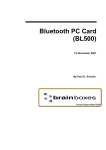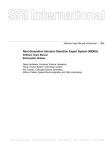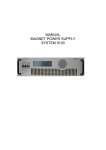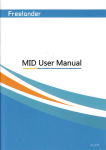Download Ameriphone RC-100 Operating instructions
Transcript
RC DIALOGUE RC REMOTE CONTROL SPEAKERPHONE Model RC-100 and RC-200 Operating Instructions 520001 © AMERIPHONE 1/03 RC M0168 2 ∆ IMPORTANT SAFETY INSTRUCTIONS When using your telephone equipment, always follow basic safety precautions to reduce the risk of fire, electric shock, and injury to persons, including the following: 1. Read and understand all Instructions. Observe all warnings and other markings on the product. 2. During thunderstorms, avoid using telephones except cordless models. There may be a slight chance of electric shock from lightning. 3. Do not use a telephone near a gas leak. If you suspect a gas leak, report it immediately, but use a telephone away from the area where gas is leaking. 4. Do not use this product near water, or when you are wet. For example, do not use it in a wet basement or shower, or next to a swimming pool, bathtub, kitchen sink or laundry tub. Do not use liquids or aerosol sprays for cleaning. If the product comes in contact with any liquids, unplug any line or power cord immediately. Do not plug the product back in until it has dried thoroughly. 5. Install this product in a protected location where no one can trip over any line or power cord. Protect cords from damage or abrasion. 6. If this product does not operate normally, read “In Case of Difficulty” on page 12. If you cannot resolve the problem, or if the product is damaged, refer to the Ameriphone Warranty. Do not open this product except as may be directed in this owner’s manual. Opening this product or reassembling it incorrectly may expose you to hazardous voltages or other risks. Opening this product automatically voids the warranty. 7. If this product uses batteries as power back-up during power outages, replace batteries only as described in this owner’s manual. Do not burn or puncture used batteries — they contain caustic chemicals. 8. Unplug this product from the wall outlet and refer servicing to qualified service personnel under the following conditions: A. When the power supply cord or plug is damaged or frayed. B. If liquid has been spilled on the product. C. If the product has been exposed to rain or water. D. If the product does not operate normally by following the operating instructions. Adjust only those controls that are covered by the operating instructions because improper adjustment of other controls may result in further damage. E. If the product has been dropped or appears damaged. F. If the product exhibits a distinct change in performance. 9. If this product has a polarized plug with one wide prong, it may not fit in non-polarized outlets. Do not defeat the purpose of these plugs. If they do not fit in your outlet, the outlet should be replaced by an electrician. ADDITIONAL SAFETY NOTES FOR CANADIAN USERS NOTICE: The Canadian Department of Communications label identifies certified equipment. This certification means that the equipment meets certain telecommunications network protective, operational and safety requirements. The department does not guarantee the equipment will operate to the user's satisfaction. Before installing the equipment, users should ensure that it is permissible to be connected to the facilities of the local telecommunications company. The equipment must also be installed using an acceptable method of connection. The customer should be aware that compliance with the above conditions may not prevent degradation of service in some situations. Repairs to certified equipment should be made by an authorized Canadian maintenance facility designated by the supplier. Any repairs or alteration made by the user to this equipment, or equipment malfunctions, may give the telecommunications company cause to request the user to disconnect the equipment. Users should ensure for their own protection that the electrical ground connections of the power utility, telephone lines and internal metallic water pipe system, if present, are connected together. This precaution may be particularly important in rural areas. CAUTION: Users should not attempt to make such connections themselves, but should contact the appropriate electric inspection authority, or electrician, as soon as possible. NOTICE: The LOAD NUMBER (LN) assigned to each terminal device denotes the percentage of the total load to be connected to a telephone loop which is used by the device, to prevent overloading. The termination on a loop may consist of any combination of devices subject only to the requirement that the sum of the load numbers of all devices does not exceed 100. SAVE THESE INSTRUCTIONS TABLE OF CONTENTS CHAPTER 1. INTRODUCTION ..............................................................................................2 CHAPTER 2. PACKAGE CHECKLIST ..................................................................................2 CHAPTER 3. FEATURES IDENTIFICATION ..........................................................................3 CHAPTER 4. INSTALLATION ................................................................................................4 A. Batteries ....................................................................................................4 B. Connections ..............................................................................................4 C. Setting Up Your RC ..................................................................................4 CHAPTER 5. OPERATION ....................................................................................................6 A. Programming Numbers Into Memory ........................................................6 B. Making Phone Calls ..................................................................................6 1. Dialing on the keypad ..................................................................6 2. Memory dialing from console ........................................................6 3. Auto dialing the first number stored in M1 ....................................7 4. Dialing using the Scan button ......................................................7 5. Dialing using the Remote Transmitter ..........................................7 C. Answering Phone Calls ............................................................................7 1. Using the keypad ..........................................................................7 2. Using the Remote Transmitter ......................................................7 3. Voice activated answering ............................................................8 D. Other Operations ......................................................................................8 1. Redialing ......................................................................................8 2. Flash ............................................................................................8 3. Voice mail indicator ......................................................................8 4. Unanswered call indicator ............................................................8 5. Telebanking and credit card calling ..............................................8 CHAPTER 6. OPTIONAL ACCESSORIES ............................................................................9 A. Air Switch™ ..............................................................................................9 B. Pillow Switch..............................................................................................9 C. Lapel Microphone......................................................................................9 D. Headset ....................................................................................................9 QUICK START GUIDE/SUMMARY ......................................................................................10 CHAPTER 7. IN CASE OF DIFFICULTY ..............................................................................12 CHAPTER 8. MAINTENANCE ..............................................................................................14 CHAPTER 9. FCC INFORMATION ......................................................................................14 CHAPTER 10. WARRANTY..................................................................................................15 CHAPTER 11. FEATURE SUMMARY ..................................................................................16 INDEX........................... ........................................................................................................16 CHAPTER 1 INTRODUCTION Thank you for selecting the exciting new DIALOGUE RC Remote Control Speakerphone from AMERIPHONE, Inc. It has been designed to meet the highest quality standards in order to provide you with years of convenient and trouble–free service. CHAPTER 2 PACKAGE CHECKLIST Your DIALOGUE RC package includes the items as shown below: Please read these operating instructions thoroughly before using the DIALOGUE RC. Or, to begin using the DIALOGUE RC as quickly as possible, see Chapter 5 "Quick Start Guide/Summary". Keep this manual for future reference. You must save your sales receipt as proof of purchase in the event that you need warranty service. If you have any questions about your DIALOGUE RC, please call our Customer Service Department at: (714)897–0808 (714)897–4703 Fax Figure 1 – DIALOGUE RC Components. 2 CHAPTER 3 FEATURES IDENTIFICATION Jack for Air Switch or accessory switch AC adapter plug Phone line jack Ringer volume control AC ADAPTER AIR SWITCH PHONE LINE OFF LO HI RINGER Lapel Microphone jack Headset port (Operational in RC–200 only) Memory location indicators M1 TM POWER Memory directory Memory buttons M2 Power indicator M3 Speaker M4 Battery compartment (underneath) M5 Tone/pulse selector (underneath) DIALOGUE R C M6 M7 M8 M9 2 A B C 3 D E F 4 G H I 5 J K L 6 M N O Headset on/off button (Operational in RC–200 only) 7 P R S 8 T U V 9 W X Y Mute button * 0 O P R M10 VOL PROG SCAN Remote Flash on/off switch, underneath (Operational in RC–200 only,) 1 MUTE FLASH/PAUSE HEADSET REDIAL MIC # Flash/Pause button On/Off button Redial button ON/OFF Voice Mail/Unanswered Call Indicator Microphone Scan button Volume control Memory Program button Figure 2 – Features Identification 3 CHAPTER 4 INSTALLATION A. Battery (included with RC–200) B. Connections Speakerphone 1. Six "AA" size, Nickel Cadmium (NiCad) rechargeable batteries are used for back–up during a power outage (Fig 3). They power the DIALOGUE RC for Figure 3 – battery compartment approximately 3 hours. DO NOT USE ALKALINE BATTERIES, they will damage your equipment. Remote Transmitter 2. Install the "23A" size 12V alkaline cigarette lighter battery in the Remote Transmitter (included) as shown (Fig 4). With normal usage, it lasts 6–12 months. If the power indicator light is faint or does not come on when the button is pressed, replace the battery. The Remote Transmitter has an operating range of up to 40 feet. Figure 4 – Remote Transmitter 4 Y ER TT BA Battery compartment Thread both ends of necklace through hole and tie a small knot. (optional) 1. Connect the phone line and AC adapter as shown. 2. Set the tone/pulse selector (T/P) to T if you have touch tone service, set to P if you have pulse dialing (rotary). (See Fig 2) The DIALOGUE RC can be placed on a desk, or mounted on the wall. Do not put the DIALOGUE RC on or next to metal surfaces, computers, televisions, radios, microwaves, or other electrical equipment that can cause interference to the wireless signal from the Remote Transmitter. C. Setting up your RC The DIALOGUE RC comes with the following operating settings from the factory: Power indicator Jack for accessory switch Figure 5 – Connection of phone line and AC adapter 1. Scan rate is 5 seconds per memory location. 2. Voice activated answering (RC–200 only) is off. 3. Unanswered call indicator is on. 4. Voice mail indicator (RC–200 only) is off. 5. Tone/pulse switch set to Tone. 6. Ring volume set to Hi. 7. "0" (operator) is programmed into first memory location of M1. 8. Remote flash switch (RC–200 only) is off. CHAPTER 4 (CONTINUED) You may set up the DIALOGUE RC in the following manner to better suit your needs. 3. Press SCAN button. MUTE VOL PROG SCAN HEADSET Setting the Scan Function MIC If you have DIALOGUE RC–100: Only the first six numbers in the memory are automatically scanned. It stops at each memory location for 5 seconds to allow you to select. To turn scan function off (or on): 1. Press PROGRAM. 2. Press 0 on the keypad to turn it off; or press 1 key on the keypad to turn it on. 3. Press SCAN button. If you have DIALOGUE RC–200: All memory locations with numbers stored are automatically scanned. The scan rate determines how long the DIALOGUE RC–200 pauses at each memory location before moving on to the next one. To turn scan function on or off: 1. Press PROGRAM. MUT VOL PROG HEAD SCAN MIC Figure 6 2. Using chart, select length of pause and press the corresponding digit on keypad. Key Entered Length of Pause at Each Location in Seconds Scan Function Off 5 4.5 4 3.5 3 2.5 2 1.5 1 Figure 7 Figure 8 To turn Voice Activation on (or off) (RC–200 only): 1. Press PROGRAM. 2. Press MUTE button twice. The MUTE indicator flashes once, and the RC200 emits four beeps to confirm that Voice Activation has been turned on. 3. To turn it off, repeat steps 1 and 2. This command is confirmed by four beeps. To turn the Unanswered Call Indicator (RC-200) feature off (or on): 1. Press PROGRAM. 2. Press HEADSET button twice. (Emits four beeps to confirm command). 3. To turn it on again, repeat steps 1 and 2, and the HEADSET indicator flashes once. To turn the Voice Mail Indicator feature on (or off), (RC–200 only): 1. Press PROGRAM. 2. Press FLASH/PAUSE button twice. RC–200 emits four beeps and the FLASH/PAUSE indicator flashes once. 3. To turn it off again, repeat steps 1 and 2, and the FLASH/PAUSE indicator does not flash. To turn the Remote Flash feature on (or off) (RC–200 only): 1. Slide remote flash switch to "On" (or "Off") position. 5 CHAPTER 5 OPERATION For optimum communication clarity, speak into the DIALOGUE RC as close as possible, not to exceed 15 feet away. Keep the microphone free from obstructions. Do not speak at the same time as the other person. Also, adjust the volume control and set the ring volume to best suit your hearing needs. A. Programming numbers into memory Your DIALOGUE RC can store up to 20 numbers (two numbers per button) in its memory for fast, one–touch dialing. When programming, pressing the FLASH/PAUSE button between numbers inserts a 2 second pause in dialing. To program a number into memory: 1. Press PROGRAM. MUTE VOL PROG HEADSET SCAN B. Making phone calls Dialing on the keypad 1. Press ON/OFF button and listen for dial tone. MUTE FLASH/PAUSE HEADSET REDIAL ON/OFF MIC Figure 11 2. Dial the number on the keypad. (If no number is dialed within 7 seconds, DIALOGUE RC automatically dials the first number stored in memory location M1.) M9 M10 VOL OG SCAN MUTE FLASH/PAUSE HEADSET REDIAL ON/OFF MIC Figure 12 3. When finished, press the ON/OFF button to hang up. MIC Memory dialing from console Figure 9 1. For the first number stored in each memory button, press the memory button once. Figure 13 For the second number, press the memory button twice. The indicator light on the directory shows the memory selected. M8 2. Dial the number (up to 40 digits). M9 M9 M10 M10 VOL ROG SCAN MUTE FLASH/PAUSE HEADSET REDIAL MUTE FLASH/PAUSE HEADSET REDIAL VOL ON/OFF PROG SCAN ON/OFF MIC MIC Figure 10 3. Select the memory button to store this number, press once for first location, or twice for second location. When the number is programmed, it emits four "beeps" to confirm the number is stored. 4. If you make a mistake or want to change the number, repeat from step 1. 5. To erase a number, press PROGRAM, then FLASH/PAUSE, and then the corresponding memory location. 6 2. The number is dialed after a 3 second wait, allowing you time to change your selection. 3. When finished, press the ON/OFF button to hang up. MUTE FLASH/PAUSE HEADSET REDIAL ON/OFF MIC Figure 14 CHAPTER 5 (CONTINUED) Auto Dialing the first number stored in M1. A. From keypad 1. Press ON/OFF button or just press M1. 2. The number is dialed automatically within 7 seconds. B. Using Remote Transmitter With Scan function on: 1. Press Remote Transmitter. 2. The number is dialed automatically after scanning all memories 3 times. C. With Scan function off: 1. Press Remote Transmitter. 2. The number is dialed automatically. Dialing by using the SCAN button Before you can use memory scanning for dialing, you must have the phone numbers stored in the memory first (page 6). To use memory scanning, the Scan function must be on. See Chapter 4 section C. Memory locations with no number stored are skipped. The memory directory is scanned three times or until a number is selected. If no number is selected, the first number in M1 is dialed. PROG MUTE FLASH/PAUSE HEADSET REDIAL ON/OFF MIC 5. Press the ON/OFF button to hang up. Figure 16 Dialing using the Remote Transmitter A. With Scan function on: 1. Press the Remote Transmitter to begin scanning. Figure 17 2. When the desired memory location is lit, press the Remote Transmitter. The DIALOGUE RC automatically dials the number selected. 3. Press the Remote Transmitter once to hang up. B. With Scan function off: 1. Press the Remote Transmitter once. 2. It dials the first number stored in M1. C. Answering phone calls MUTE VOL 1. Press the SCAN button. 4. The DIALOGUE RC automatically dials the number selected. SCAN HEADSET MIC Figure 15 2. The memory location indicators light up as it scrolls down the memory locations. If you have DIALOGUE RC–100: Only the first six memory locations are scanned. If you have DIALOGUE RC–200: All 20 memory locations are scanned (It "beeps" when advancing to the next memory location.) 3. When the desired memory location is lit, press the SCAN button again to select. Using the keypad 1. When the phone rings, press the ON/OFF button to turn it on. 2. When finished, press the ON/OFF button to hang up. MUTE FLASH/PAUSE HEADSET REDIAL ON/OFF MIC Figure 18 Using the Remote Transmitter 1. When the phone rings, press the Remote Transmitter to turn on. 2. Press the remote button once to hang up. Figure 19 7 CHAPTER 5 (CONTINUED) Voice Activated answering (DIALOGUE RC–200 only) 1. The voice activated Answering feature has been preset to OFF in the factory. To activate this feature, see page 5. 2. Say "Hello" or whistle loudly, between rings. (If a headset is used, answer by speaking into the headset microphone.) 3. Use the remote control, or press the ON/OFF button on the console to hang up. Please Note: When the party that called you hangs up, the telephone company switching office may re-establish a dial tone on your line. When dial tone returns, your RC–200 will hang up automatically. Prior to hanging up, the RC–200 emits two short beeps as a reminder. D. Other Operations MUTE FLASH/PAUSE HEADSET REDIAL ON/OFF MIC Figure 20 ADSET MUTE REDIAL ON/OFF FLASH/PAUSE REDIAL ON/OFF If the DIALOGUE RC rings three or more times and is not Figure 23 answered, the FLASH/PAUSE light flashes to indicate that you missed a call.Turning on the DIALOGUE RC cancels the indicator. ON/OFF Figure 21 Flash button The flash button is used to access special telephone functions and services available from your local phone company, such as call waiting, 3–way calling, and others. Call your phone company for more information. 8 MUTE Telebanking and Credit Card Calling FLASH/PAUSE REDIAL If you subscribe to voice mail service from your phone company, the FLASH/PAUSE light flashes and the RC beeps (once every 3.5 minutes) to inform you that you have voice mail messages. You also hear a special "stutter" dial tone sent from the FLASH/PAUSE phone company. To retrieve your messages, follow the instructions Figure 22 provided by your phone company. Making an outgoing call cancels the indicator light. ADSET OR 2. Press and hold the Remote Transmitter for 3 seconds, until the ON/OFF indicator on DIALOGUE RC turns on. Voice Mail Indicator (VMI) Unanswered Call Indicator Redialing the last number dialed 1. Press the REDIAL button on the keypad. If you have the DIALOGUE RC–200, you can use the Flash feature with the Remote Transmit-ter. Turn the Remote Flash switch on (see Chapter 4 section C). When you are on the phone line, press the Remote Transmitter button twice in succession, within three seconds, to generate the “flash”. You can transmit account or personal identification numbers (PIN) from the DIALOGUE RC by pre–storing them in memory. 1. Program account or PIN numbers into a memory location in advance by following the same steps you would program a phone number. 2. When the automated phone system requests it, press the memory button where your account number or PIN is stored. CHAPTER 6 OPTIONAL ACCESSORIES A. AIR SWITCH™ This Accessory switch allows you to place and answer calls and control every function of the Dialogue RC by blowing gently on its air sensor. It snaps on to either the rear of the console or the remote control for the ultimate in “no-touch” accessory and control. C. LAPEL MICROPHONE This highly sensitive microphone, clips to your collar and provides handsfree, crystal clear, high fidelity sound for people who have weak voices. It has a cord that is 5 feet long. D. HEADSET WITH MICROPHONE Ensure the utmost privacy for personal conversations or confidential business calls. This light weight unit plugs into the telephone with a 61/2 foot long cord and is comfortable to wear, even for extended periods of time. B. PILLOW SWITCH Plugs into the console or the remote control for your convenience. Allows you to control phone functions by gently touching it with your arm, leg, head, shoulder or other body movement. A 6 foot long cord connects it easily. For a complete catalogue, please call or write: AMERIPHONE, Inc., Product Catalogue 12082 Western Ave., Garden Grove, CA 92841 (714) 897-0808 VOICE (714) 897-1111 TTY (714) 897-4703 FAX 9 QUICK START GUIDE/ SUMMARY For more detailed description see Chapter 5. OPERATION FACTORY PRESET MODES OF OPERATION: TO CHANGE MODES OF OPERATION Setting the Scan Function If you have DIALOGUE RC-100 To turn Scan function off (or on): If you have DIALOGUE RC-200 To turn Scan function off (or on): To turn Voice Activation on (or off), (RC-200 only): To turn the Unanswered Call Indicator feature off (or on): To turn the Voice Mail Indicator feature on (on off), (RC-200 only): PROGRAMMING NUMBERS INTO MEMORY STEPS • • Scan rate = 5 seconds per memory location. Tone/pulse switch set to Tone. 1 Press PROGRAM. 1 Press PROGRAM. 1 Press PROGRAM. 1 Press PROGRAM. 1 Press PROGRAM. 1 Press PROGRAM. MAKING A CALL BY DIALING ON THE RC A. From the keypad B. Auto Dialing the first number stored in M1 1 Press ON/OFF button. 1 Press ON/OFF button. C. Memory Dialing 1 Press a memory button once to dial the first stored number, twice for the second number. MAKING A CALL USING THE REMOTE TRANSMITTER 1 Press Remote Transmitter once. A. With Scan function on B. With Scan function off ANSWERING A CALL A. From the keypad B. Using the Remote Transmitter C. Using Voice Activation, (DIALOGUE RC-200 only). 10 1 Press Remote Transmitter once. 1 Press ON/OFF button to answer. 1 Press Remote Transmitter once to answer. 1 Say “Hello” or whistle between rings to turn on phone. • • Voice Activated answering is off, (RC-200 only). Ring volume set to Hi. • • Unanswered call indicator is on. ”0“ (operator) is programmed into the first memory location of M1. • • Voice Mail indicator is off, (RC-200). Remote Flash switch is off, (RC-200 only). 2 Press 0 on the keypad to 3 Press SCAN button. turn it off; or Press 1 key on the keypad to turn it on. 2 Press 0 key to turn it off; or 3 Press SCAN button. Press 1-9 keys to turn it on. See Page 5 for rate selection guide. 2 Press MUTE twice. 2 Press HEADSET twice. 2 Press FLASH/PAUSE twice. 2 Dial the number (up to 40 digits). 2 Dial the number. 2 The number is dialed in 3 Select the memory button. Press once for first location, or twice for second location. 3 Press ON/OFF button to hang up. 7 seconds. 2 When the desired directory 3 Press Remote Transmitter to hang up. location is lit, press it again. 2 The first number stored under M1 is dialed. 3 Press Remote Transmitter once to hang up. 2 Press ON/OFF button to hang up. 2 Press Remote Transmitter once to hang up. 2 It hangs up automatically after one minute of silence or when it detects dial tone. 11 CHAPTER 7 IN CASE OF DIFFICULTY If any problem should occur during operation of your DIALOGUE RC, review the list below. Should the difficulty persist, contact AMERIPHONE or your authorized dealer before sending the phone for service. SYMPTOM CAUSE AND REMEDY No dial tone – Check all phone line connections. No power – Check power connection. Does not dial out – Check all phone line connections and power connection. – Change to pulse dialing and try again. Does not dial memory number – No number programmed in memory. Remote Transmitter does not work – Check or replace battery. – Check channel settings. – Make sure no part of the DIALOGUE RC system is on or near metal surfaces or electrical equipment. No audible ring – Make sure the ringer is not set to "Off" position. Does not scan through memory – Turn on Scan function. Scanning too fast/slow – Program Scan rate to a slower/faster setting. (Dialogue RC–200 only.) Cuts in and out while speaking/ listening – Avoid speaking at the same time as the other party. Take turns. SENSITIVITY ADJUSTMENT YOU MUST CONTACT AMERIPHONE BEFORE MAKING THE FOLLOWING ADJUSTMENT: Callers can’t hear your voice when using the optional headset with integrated microphone 12 – Turn HEADSET MIC GAIN adjustment, located on bottom of unit, clockwise to increase sensitivity, counterclockwise to decrease. CHAPTER 7 (CONTINUED) ON MATCH EXA C If your system encounters interference and repeatedly activates by itself for no obvious reasons, it may be necessary to change DIP Switch settings on the DIALOGUE RC and Remote Transmitter. SE TO Your phone and remote have been preset at the factory to a standard channel setting. Under normal operating conditions, there is no adjustment necessary. 1 2 3 4 5 6 7 8 T The DIALOGUE RC and Remote Transmitter use radio signals to communicate with each other. For the Remote Transmitter to activate the DIALOGUE RC, they both have to be on the same "channel." A "DIP Switch" is used for channel selection. ON LY T CHANNEL SETTINGS 1 2 3 4 5 6 7 8 (Remove cover to expose switch) Figure 24 – Channel setup 1. Unscrew bottom of the Remote Transmitter. 2. Locate DIP Switches on Remote Transmitter and on bottom of DIALOGUE RC. 3. Using a ball point pen, change the settings on all switch positions to match exactly on both DIALOGUE RC and Remote Transmitter. 4. Replace remote cover and test. 13 CHAPTER 8 MAINTENANCE To ensure trouble–free service, your DIALOGUE RC should always be treated with care. Do not drop or subject the phone to high impact. The unit can be cleaned with a damp cloth and a mild detergent. Never use abrasives or solvents. Keep the unit plugged into the electrical outlet at all times, except when cleaning. This will automatically recharge the optional back–up batteries, and keep the phone operational for incoming calls. We recommend using a surge protector to prevent damage to the DIALOGUE RC in case of power surges or electrical storms. CHAPTER 9 FCC INFORMATION Your local telephone company is required by the FCC to allow you to connect FCC registered telephone equipment to their telephone lines. They may ask you to provide them the Federal Communications Commission (FCC) registration number and the Ringer Equivalence Number (REN) of the DIALOGUE RC printed on the label on the bottom of the unit. DIALOGUE RC uses a FCC Part 15 approved transmitter and receiver. Its operation is subject to the following two conditions: 1. This device may not cause harmful interference. 2. This device must accept any interference that may be received, including interference that may cause undesired operation. 14 CHAPTER 10 WARRANTY This warranty applies only to AMERIPHONE products that are purchased and used in the United States or Canada. AMERIPHONE, Inc. warrants the DIALOGUE RC–100 and DIALOGUE RC–200 against any defect in materials or workmanship for the period of one year from the date of purchase. If your AMERIPHONE product is defective and returned within 30 days of the date of purchase, your authorized AMERIPHONE dealer will replace it at no charge. If returned after 30 days but within one year from the date of purchase, we will repair or replace it at no charge. In the repair of your DIALOGUE RC, we may use new or reconditioned replacement parts. If we elect to replace your DIALOGUE RC, we may replace it with a new or reconditioned product of the same or similar design. Repair or replacement will be warranted for either 90 days or the remaining time on the original warranty period, whichever is longer. Implied warranties, including those of fitness for a particular purpose and merchantability (an unwritten warranty that the product is fit for ordinary use), are limited to one year from date of purchase. We will not pay for loss of time, inconvenience, loss of use of your DIALOGUE RC, or property damage caused by your DIALOGUE RC or its failure to work, or any other incidental or consequential damages. Some states do not allow limitations on how long an implied warranty lasts or the exclusion of incidental or consequential damages, so the above exclusions or limitations may not apply to you. To get warranty service for your DIALOGUE RC, you must provide proof of the purchase date. Within 30 days of the date of purchase, return your DIALOGUE RC to the place where you purchased it for immediate replacement. After 30 days, call AMERIPHONE at (714) 897–0808 for the authorized service center nearest you. You must prepay all shipping costs. We suggest you save the original packaging materials in the event you need to ship the DIALOGUE RC. When in need of warranty repair, please call our Customer Service Department at (800) 874-3005-VOICE or at (800) 772-2889-TTY. They will help you process your return shipment. This warranty does not cover defects resulting from accidents, damage while in transit to our service location, alterations, unauthorized repair, failure to follow instructions, misuse, use outside the United States or Canada, fire, flood, and acts of God. Nor do we warrant the product to be compatible with any particular telephone equipment, party line, key telephone systems or more sophisticated switching systems. If your DIALOGUE RC is not covered by this warranty, call us at (714) 897–0808 for advice as to whether we will repair your DIALOGUE RC and other repair information. The repaired parts shall be warranted for 90 days. 15 CHAPTER 11 FEATURE SUMMARY Feature Memory INDEX RC-100 RC-200 20 20 Auto dialing M1 • • Memory scanning • • No. of memory scanned 6 20 Scanning speed fixed selectable Remote dialing • • Voice activated answering • Remote flash • Voice mail indicator • Unanswered call indicator • Headset operation/ control • Connection for Air Switch or accessory switch Back-up battery provided • • • DIALOGUE RC, Air Switch, and AMERIPHONE are registered trademarks of AMERIPHONE, INC. AC adapter ..............................................4 Air switch ..................................................9 Amplification ............................................6 Assistive switches ....................................9 Auto dialing ..............................................7 Batteries ..................................................4 Channel setting ......................................13 Connections..............................................4 Credit card calling ....................................8 Dial mode ................................................4 FCC information ....................................14 Feature summary ..................................16 Flash ....................................................5, 8 Headset, accessory ..................................9 Headset button ........................................3 Installation ................................................4 Lapel microphone ....................................9 Maintenance ..........................................14 Memory dialing ........................................6 Memory, programming..............................6 Microphone ..........................................3, 6 Mounting ..................................................4 On/Off button ....................................3, 6-7 Pause ......................................................6 Pillow switch ............................................9 Power ......................................................3 Program ....................................................6 Pulse dialing ............................................4 Quick start guide ....................................10 Redial ......................................................8 Remote Transmitter ..........................4, 7-8 Remote Flash switch ........................3-5, 8 Ringer volume ................................3, 6, 10 Scan ..................................................4-5, 7 Scan rate ..................................................5 Telebanking ..............................................8 Tone dialing ..............................................4 Troubleshooting ......................................12 Unanswered call indicator ................4-5, 8 Volume..................................................3, 6 Voice Activation ................................4-5, 8 Voice Mail Indicator ..........................4-5, 8 Warranty ................................................15 16




























